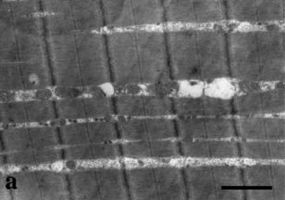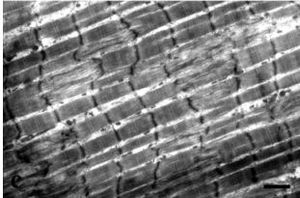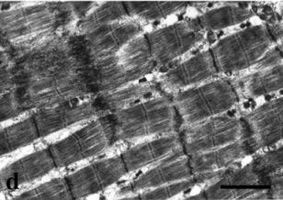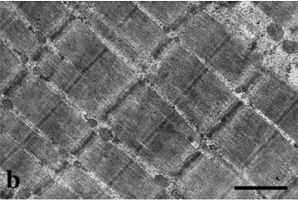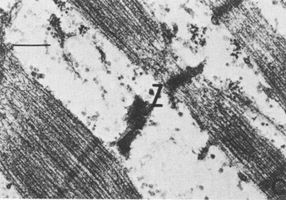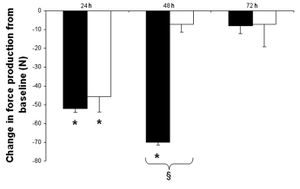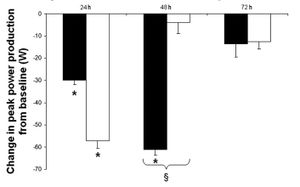Delayed Onset Muscle Soreness
Delayed Onset Muscle Soreness (DOMS) is a familiar experience to most people who exercise. It affects people who weight train and run particularly, and DOMS can produce anything from mild muscle soreness to debilitating pain and weakness. DOMS is caused by eccentric stress, where the muscles working to resist lengthening, such as lowering a weight or absorbing the landing forces of running. Downhill running is a particular source of eccentric stress. DOMS not only produces delayed soreness, but immediate weakness that generally lasts a similar length of time. DOMS also produces swelling, tense muscles, reduced coordination and a limited range of motion. A key benefit of DOMS inducing exercise is that a bout of DOMS can give protection against similar future exercise, and the protection lasts for months. Taking protein after DOMS inducing exercise is one of the best treatments, though compression clothing, caffeine and massage can also help.
Contents
1 What is DOMS?
The soreness of DOMS generally peaks between 24 and 72 hours after unusual or severe exercise, though soreness may occur sooner after running[1]. DOMS is particularly related to eccentric exercise, which is where the muscle works to resist becoming longer, rather than working to contract. When you muscles absorb the impact of running, this is eccentric exercise, and Downhill Running is more eccentric than flat or uphill running. The images below show the damage that occurs from eccentric exercise[2] and marathon running[3]:
- Muscle damage from eccentric exercise (downhill running)
- Muscle damage after running a marathon
2 What are the symptoms of DOMS?
The soreness of DOMS is different to other forms of muscle soreness. With DOMS, large areas of the muscle are tender to the touch and painful when the muscle is used. With other forms of muscle soreness the area of tenderness is usually more localized and the pain of massage is sometimes described as a 'good pain'. The pain of DOMS will normally lessen with light exercise such as walking, which is often described as 'loosening' up. In addition, there are other symptoms, such as:
- Reduction in strength[4][5][6][7], typically 30-60%[8]. (Note that the reduction in strength starts immediately following the damaging exercise and increases over the next 24-48 hours[9]. The initial reduction in strength can be as much as 40%[8].)
- Increased passive muscle tension[10]. A muscle suffering from DOMS will often be hard to the touch, even when relaxed as much as possible.
- Swelling of the muscle[10], which can be seen as a lack of muscle definition in lean individuals.
- The perceptions of joint angle and force are impaired[4], which can result in reduced coordination and a sense of clumsiness.
- A reduction in the Range of Motion[4][5][6].
- Changes in running biomechanics, possibly as compensation for other changes[11]. For instance, the reduction in Range of Motion can result in a reduction in stride length.
- Decreased Running Economy[12][13].
- Impaired Glycogen repletion[12][13], though higher carbohydrate intake partly offsets the reduction[14]. There is some evidence that Glycogen levels continue to drop after DOMS inducing exercise[15][16], and the deficiency in glycogen lasts for over 72 hours[16].
- There are some studies that indicate there are possible changes in muscle fiber recruitment patterns[17][18][19].
3 Why is DOMS important?
Because running involves a lot of eccentric stress, DOMS is common in runners, especially after Downhill Running. The pain that occurs 24-72 hours after exercise can prevent continued training. However, the biggest issue for long distance runners is that although the pain occurs 24-72 hours after exercise, the weakness peaks after 30 minutes [20]/>. If you've ever run a long, steep descent, you'll know the strange feeling of weak numbness that pervades your quads as the effect of the downhill builds up. The Boston Marathon or the latter part of Mount Mitchell Challenge have descents that cause this type of weakness. If you've felt a similar weakness in the latter stages of a marathon, this may not be Glycogen depletion creating 'the wall', but eccentric muscle damage that will later manifest itself as DOMS. It is suggested that this is the reason the Boston Marathon course is relatively slow, even though it is a net decent.
4 What does DOMS mean to you?
There is some good news in all of this. While excessive eccentric exercise can cause DOMS, doing some eccentric exercise causes the muscles to adapt and to be able to handle eccentric exercise without DOMS [21]. There are two ways then of protecting your muscles from DOMS in running; running greater distances, or running downhill. I believe that downhill running that is greatly underutilized in training regimes. Most hill training workouts focus on the uphill segment, and relegate the downhill to recovery. While uphill can produce some benefits, it is the downhill that can provide the greatest advantage. Adding hills into your workout can make you a much stronger runner, and have benefits even on flat race courses. Don't just use the downhill to recover from the uphill, but work on the downhill.
5 How to prevent or treat DOMS?
There are various approaches to preventing or treating DOMS. The table below is a summary of the approaches showing how likely the strategy is to prevent or treat DOMS combined with the possible downsides. At the top are those that are likely to help and have no downsides, then those that have no effects or downsides, then those with little benefit and significant downsides.
| Strategy | Timing | Soreness | Weakness | Downsides |
|---|---|---|---|---|
| Repeated Bout Effect | Before (days to months) | Strong evidence of reduced weakness | Some evidence of reduced weakness | None |
| Carbohydrate and/or protein | After | Some evidence of reduced soreness | Strong evidence of reduced weakness | None |
| Compression Clothing | After | Some evidence of reduced soreness | Some evidence of reduced weakness | None |
| Caffeine | After | Some evidence of reduced soreness | Some evidence of reduced weakness | None |
| Massage | After | Some evidence of reduced soreness | No benefit | None |
| Warmup | Immediately before | Some evidence of reduced soreness | No benefit | None |
| Light Exercise | After | Transient pain reduction | No benefit | None |
| TENS | After | Transient pain reduction | No benefit | None |
| Icing | After | No benefit | No benefit | None |
| Antioxidents | Before and/or After | Mixed evidence | Mixed evidence | Conflicting evidence of reduced endurance adaptations |
| Stretching | Before and/or After | No benefit | No benefit |
|
| NSAIDs | Before and/or After | Most evidence indicates no benefit | Most evidence indicates no benefit | Can impair recovery |
5.1 Repeated Bout Effect
The DOMS that follows an initial bout of eccentric exercise is much less on subsequent similar bouts. This is often called the Repeated Bout Effect (RBE)[10][9]. The initial bout does not have to cause significant soreness or damage[22]. As few as 2-10 maximal eccentric repetitions can protect against a subsequent larger bout (24-50), but the initial bout must be close to maximal effort[23]. By contrast, eight weeks of training with 50% of the maximal eccentric load did not provide protection against a subsequent maximal bout[24]. There is some cross-over of protection between different forms of exercise. For instance, eccentric weight training protects against soreness and weakness in subsequent downhill running[25]. The protection from the RBE is long lived. One study showed that while the initial weakness was not reduced by the RBE, the recovery of strength was much faster for up to 9 months, and soreness was less for up to 6 months[26]. Another study showed that 30 minutes of downhill running provides protection for between 6 and 9 weeks[27]. There is evidence that the RBE may rapidly start to provide protection from soreness and weakness[28], possibly as soon as 24 hours post exercise[29].
5.2 Carbohydrate and Protein
Main article: Nutrient Timing
The damage of DOMS requires repair, so it's not surprising that taking protein or amino acids, which are the building blocks of the muscle fibers, helps with recovery.
- Most studies show that amino acids reduce muscle soreness[30][31] [32][33], and may[33][31] or may not reduce weakness[34][35][34].
- Most studies have shown that protein will reduce muscle weakness after DOMS inducing exercise[36][37] [38][39][40], with only two studies showing no improvement[41][42].
- The effect of protein on soreness is more mixed with some studies showing improvement[43] [44][40], but others not[36][45][42].
- Not surprisingly timing may be important, with CHO+PRO having an effect on muscle weakness directly after or 24 hours after, but not before DOMS inducing exercise[39], as shown below.
- In addition to reducing muscle soreness, protein supplementation in military recruits also reduced illness and injury[44].
- Taking carbohydrate alone after DOMS inducing exercise does not appear to help[46][47].
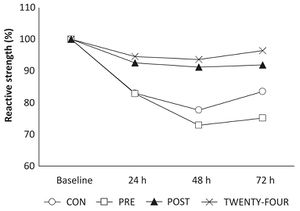
Protein helps with recovery from DOMS[40]. The graphs below show the impact of 100 grams of Protein taken immediately after 30 minutes of downhill running. Note that muscle soreness peaked at 72 hours, even though force and power had returned to baseline.
5.3 Compression Clothing
Main article: Why compression clothes
Studies show that wearing Graduated Compression Clothing during the days after DOMS inducing exercise mitigates the soreness[48][49][50][51][52][53][54] and weakness[49][51][52] of DOMS. Relatively few studies showed no benefit from compression clothing[55][56]. However, the results of compression clothing are likely to vary with the particular garment, how well it fits and therefore the pressure that is provided[57]. No studies were found that looked at the effect of wearing compression clothing during DOMS inducing exercise on the subsequent recovery.
5.4 Caffeine
Main article: Caffeine
Caffeine has shown to be effective in reducing the pain of DOMS, as well as reducing the weakness[58]. (The reduction in weakness did not reach statistical significance in regular caffeine users[59].) While the evidence for caffeine reducing the weakness of DOMS, this is one of the few approaches that can help offset the weakness during the damaging exercise.
5.5 Massage
Main article: Massage
Massage is widely used to prevent and treat injuries. Most meta-analysis suggest that post-exercise massage helps with the soreness of DOMS[60][61], though the mechanisms are unclear[62]. Studies that give massage 2-3 hours after DOMS inducing exercise showed reduced soreness[63][64][65], but not weakness[64][65]. One study that gave massage 2 days after exercise that resulted in reduced soreness and improved muscle function[66], but other studies that use massage 24 hours or more after exercise showed no benefit[67][68]. Therefore it seems likely that the timing of the massage is important, though other factors, such as the style of massage and the extent of the DOMS may also change the outcome.
5.6 Warmup
Main article: Warmup
Performing a Warmup before exercise may help reduce DOMS pain[69][70], but not all studies support this[71].
5.7 Light Exercise
Light training in the days following DOMS inducing exercise generally accepted to be one of the most effective ways of reducing muscle soreness, but unfortunately the reduction in pain is temporary[72][73][10][9].
5.8 TENS
TENS may reduce the soreness of DOMS[74], but the effect seems to be transient[75] and the effect is reduced if combined with icing[76]. Not all studies show any pain reduction[77] and none show a reduction in the weakness.
5.9 Icing
Main article: Cryotherapy
Icing does not help[78][79][80][7], and can make DOMS worse[81][82]. Ice reduces pain slightly, but does not restore strength[76]
5.10 Antioxidants - Vitamin C and E
The evidence for anti-oxidants is mixed, with some studies showing a benefit but not others. Note that one study below showed an impaired recovery with vitamin C supplementation. In addition, there is mixed evidence that vitamin C and/or vitamin E reduces endurance adaptations from exercise[83][84][85] or they do not[86][87] [88].
| Vitamin C | Vitamin E | Dose Period | Result |
|---|---|---|---|
| 3,000mg/day | 14 days prior and 4 days post-exercise | Vitamin C reduces soreness in first 24 hours[89] | |
| 3,000mg/day | 3 days prior and 4 days post-exercise | reduced soreness[90] | |
| 400mg/day | 14 days prior to exercise | reduced soreness[91] | |
| 3,000mg/day | 3 days prior and 5 days post-exercise | no effect[92] | |
| 1,000mg/day | 2 hours prior and 4 days post-exercise | no soreness change, but impaired strength recovery 7 and 14 days after exercise[93] | |
| 1,000mg | 2 hours prior to exercise | no effect[94] | |
| 400mg/day | 12 days prior and 3 days post-exercise | no change in soreness[95] | |
| 1,200 IU/day | 30 days prior to exercise | No effect[96] | |
| 500mg/day | 1,200 IU/day | 30 days prior and 7 days post-exercise | improved muscle function but no change in soreness[97] |
| 1,000mg/day | 300 mg/d | 6 weeks prior to exercise | no change in function[98] |
5.11 Stretching
Main article: Stretching
Stretching before[99][100] [101], after [100][102][103], or both before and after[104] exercise does not help with DOMS. In fact, stretching alone can induce DOMS[105].
5.12 NSAIDs
Main article: NSAIDs and Running
The most common NSAIDs (Ibuprofen, Acetaminophen (Paracetamol), and Aspirin) are unlikely to help with DOMS, but Naproxen may reduce the pain and weakness. If an NSAID is taken, it should probably be immediately after the damaging exercise rather than waiting until the soreness develops. It seems likely that taking an NSAID for DOMS will reduce the muscular growth that would normally occur as part of the recovery. In one disturbing study, rabbits treated with an NSAID (flurbiprofen) after DOMS inducing exercise initially recovered their strength after 3-7 days, but between days 7 and 28 days the rabbits became weaker while the untreated controls became stronger[106]. I have not included other animal studies, but this is the only one that looks at how NSAIDs impact the longer term recovery from DOMS.
| NSAID | Soreness | Weakness |
|---|---|---|
| Ibuprofen | 2xImproved[107][108] | 1xMaybe[107] |
| Ibuprofen Gel | 1xNo Effect[115] | |
| Acetaminophen (Paracetamol) | 2xNo Effect[116][117] | |
| Aspirin | 2xImproved[118][119] | 2xNo Effect[118][119] |
| Naproxen | 4xImproved[120][121][122][123] 1xNo Effect[124] |
3xImproved[120][121][122] 1xNo Effect[124] |
| Diclofenac | Possible slight reduction[125] | |
| Codeine | 1xNo Effect[116] | |
| Rofecoxib | 1xNo Effect[126] | |
| Ketoprofen | 1xImproved[127] | 1xImproved[127] |
| Bromelain | 1xNo Effect[114] |
6 Mechanisms of DOMS
The underlying mechanism of DOMS is thought to consist of phases; the initial damage that occurs during the exercise and then secondary damage that occurs subsequently[9][10]:
- Primary damage. The initial damage is believed to be mechanical in nature, both on the contracting parts of the muscle (sarcomeres) and the supporting structures (primarily the z-bands). While there are some suggestions that the primary damage might be due to metabolic factors such as low blood flow, low oxygen saturation, impaired metabolite clearance, these causes are not well supported. The idea that DOMS is caused by lactic acid has been rejected[128].
- Secondary damage. The secondary damage appears to be initiated by the disruption of the intracellular Ca2+homeostatis, which leads to further myofibrillar damage including degradation of the cell membrane.
6.1 Mechanisms for the Repeated Bout Effect
For those interested in the details, there are several possible mechanisms that might be responsible for the Repeated Bout Effect (RBE)[129][130]:
- Neural adaptation. The RBE may be due to changes in the way muscles are recruited. While there is some direct evidence that RBE occurs without neural adaptations, it is possible that this mechanism contributes to the protection.
- Increased recruitment of slow-twitch fibers. Fast-twitch fibers may be more susceptible to eccentric damage, so an adaptation to recruit more slow-twitch fibers might reduce DOMS.
- Activation of more muscle fibers. Recruiting a larger number of fibers may reduce the eccentric stress on each fiber, thus reducing the damage.
- Mechanical adaptation. It is possible to consider muscle damage as similar to materials fatigue. These adaptations are in the non-contracting structures of the muscles. For instance, protection from damage could come from increased structural strength in the z-band of the muscles which get disturbed by eccentric exercise as seen above.
- Increased dynamic muscle stiffness. Dynamic stiffness refers to how stiff the muscles are when contracted.
- Increased passive muscle stiffness. In contrast, passive stiffness is when the muscles are relaxed. It is unclear if increased passive stiffness protects against eccentric damage or actually exacerbates it.
- Cellular adaptation. A number of changes at the cellular level may provide protection against eccentric damage.
- Increased sarcomeres. The sarcomeres are part of the contracting mechanism of the muscles. The contraction of a muscle comes from parts of the sarcomere sliding over each other. One adaptation to eccentric exercise may be that the overlap in these sliding areas becomes larger.
- Changed inflammation response. The delay in soreness is probably due to a delayed inflammatory response, so changes in that response could reduce the soreness. However, this would not reduce the immediate loss of strength.
- Maintenance of Excitation-Contraction coupling. One reason for the loss of strength following eccentric exercise is that the nerve impulses (excitation) may result in less contraction. The decoupling could be due to lack of neural drive (perhaps due to pain), physical disruption of the contracting structures of the muscle, or a failure to activate those contracting structures.
7 See Also
8 References
- ↑ Template:cite journal
- ↑ Template:cite journal
- ↑ Warhol, MJ.; Siegel, AJ.; Evans, WJ.; Silverman, LM. (Feb 1985). "Skeletal muscle injury and repair in marathon runners after competition.". Am J Pathol 118 (2): 331-9. Template:citation/identifier.
- ↑ 4.0 4.1 4.2 Saxton, JM.; Clarkson, PM.; James, R.; Miles, M.; Westerfer, M.; Clark, S.; Donnelly, AE. (Aug 1995). "Neuromuscular dysfunction following eccentric exercise.". Med Sci Sports Exerc 27 (8): 1185-93. Template:citation/identifier.
- ↑ 5.0 5.1 Delayed Onset Muscle Soreness and Decreased Isokinetic Stren... : The Journal of Strength & Conditioning Research http://journals.lww.com/nsca-jscr/abstract/1988/05000/delayed_onset_muscle_soreness_and_decreased.1.aspx
- ↑ 6.0 6.1 Gulick, DT.; Kimura, IF.; Sitler, M.; Paolone, A.; Kelly, JD. (Apr 1996). "Various treatment techniques on signs and symptoms of delayed onset muscle soreness.". J Athl Train 31 (2): 145-52. Template:citation/identifier.
- ↑ 7.0 7.1 Paddon-Jones, DJ.; Quigley, BM. (Nov 1997). "Effect of cryotherapy on muscle soreness and strength following eccentric exercise.". Int J Sports Med 18 (8): 588-93. Template:citation/identifier. Template:citation/identifier.
- ↑ 8.0 8.1 Baldwin Lanier, A. (2003). "Use of nonsteroidal anti-inflammatory drugs following exercise-induced muscle injury.". Sports Med 33 (3): 177-85. Template:citation/identifier.
- ↑ 9.0 9.1 9.2 9.3 Cheung, K.; Hume, P.; Maxwell, L. (2003). "Delayed onset muscle soreness : treatment strategies and performance factors.". Sports Med 33 (2): 145-64. Template:citation/identifier.
- ↑ 10.0 10.1 10.2 10.3 10.4 Howatson, G.; van Someren, KA. (2008). "The prevention and treatment of exercise-induced muscle damage.". Sports Med 38 (6): 483-503. Template:citation/identifier.
- ↑ Muscle Soreness During Running: Biomechanical and Physiological Considerations http://journals.humankinetics.com/jab-back-issues/jabvolume7issue2may/musclesorenessduringrunningbiomechanicalandphysiologicalconsiderations
- ↑ 12.0 12.1 Smith LL. Causes of delayed onset muscle soreness and the impact on athletic performance: a review. J Appl Sport Sci Res 1992; 6 (3): 135-41
- ↑ 13.0 13.1 Braun, WA.; Dutto, DJ. (Sep 2003). "The effects of a single bout of downhill running and ensuing delayed onset of muscle soreness on running economy performed 48 h later.". Eur J Appl Physiol 90 (1-2): 29-34. Template:citation/identifier. Template:citation/identifier.
- ↑ Costill, DL.; Pascoe, DD.; Fink, WJ.; Robergs, RA.; Barr, SI.; Pearson, D. (Jul 1990). "Impaired muscle glycogen resynthesis after eccentric exercise.". J Appl Physiol 69 (1): 46-50. Template:citation/identifier.
- ↑ Zehnder, M.; Muelli, M.; Buchli, R.; Kuehne, G.; Boutellier, U. (Jun 2004). "Further glycogen decrease during early recovery after eccentric exercise despite a high carbohydrate intake.". Eur J Nutr 43 (3): 148-59. Template:citation/identifier. Template:citation/identifier.
- ↑ 16.0 16.1 Widrick, JJ.; Costill, DL.; McConell, GK.; Anderson, DE.; Pearson, DR.; Zachwieja, JJ. (May 1992). "Time course of glycogen accumulation after eccentric exercise.". J Appl Physiol 72 (5): 1999-2004. Template:citation/identifier.
- ↑ Miles, MP.; Ives, JC.; Vincent, KR. (1997). "Neuromuscular control following maximal eccentric exercise.". Eur J Appl Physiol Occup Physiol 76 (4): 368-74. Template:citation/identifier.
- ↑ Zhou, S.; Carey, MF.; Snow, RJ.; Lawson, DL.; Morrison, WE. (Mar 1998). "Effects of muscle fatigue and temperature on electromechanical delay.". Electromyogr Clin Neurophysiol 38 (2): 67-73. Template:citation/identifier.
- ↑ Zhou, S. (Jun 1996). "Acute effect of repeated maximal isometric contraction on electromechanical delay of knee extensor muscle.". J Electromyogr Kinesiol 6 (2): 117-27. Template:citation/identifier.
- ↑ Marginson, V.; Rowlands, AV.; Gleeson, NP.; Eston, RG. (Sep 2005). "Comparison of the symptoms of exercise-induced muscle damage after an initial and repeated bout of plyometric exercise in men and boys.". J Appl Physiol 99 (3): 1174-81. Template:citation/identifier. Template:citation/identifier.
- ↑ Skeletal muscle damage and repair http://books.google.com/books?id=ueMh1x7kFjsC&lpg=PA195&ots=wwIhuoi0Nt&dq=Tiidus%201997&pg=PA69#v=onepage&q=Tiidus%201997&f=true
- ↑ Clarkson, PM.; Byrnes, WC.; Gillisson, E.; Harper, E. (Oct 1987). "Adaptation to exercise-induced muscle damage.". Clin Sci (Lond) 73 (4): 383-6. Template:citation/identifier.
- ↑ Brown, SJ.; Child, RB.; Day, SH.; Donnelly, AE. (Apr 1997). "Exercise-induced skeletal muscle damage and adaptation following repeated bouts of eccentric muscle contractions.". J Sports Sci 15 (2): 215-22. Template:citation/identifier. Template:citation/identifier.
- ↑ Nosaka, K.; Newton, M. (Jan 2002). "Concentric or eccentric training effect on eccentric exercise-induced muscle damage.". Med Sci Sports Exerc 34 (1): 63-9. Template:citation/identifier.
- ↑ Eston, RG.; Finney, S.; Baker, S.; Baltzopoulos, V. (Aug 1996). "Muscle tenderness and peak torque changes after downhill running following a prior bout of isokinetic eccentric exercise.". J Sports Sci 14 (4): 291-9. Template:citation/identifier. Template:citation/identifier.
- ↑ Nosaka, K.; Sakamoto, K.; Newton, M.; Sacco, P. (Sep 2001). "How long does the protective effect on eccentric exercise-induced muscle damage last?". Med Sci Sports Exerc 33 (9): 1490-5. Template:citation/identifier.
- ↑ Byrnes, WC.; Clarkson, PM.; White, JS.; Hsieh, SS.; Frykman, PN.; Maughan, RJ. (Sep 1985). "Delayed onset muscle soreness following repeated bouts of downhill running.". J Appl Physiol 59 (3): 710-5. Template:citation/identifier.
- ↑ Mair, J.; Mayr, M.; Müller, E.; Koller, A.; Haid, C.; Artner-Dworzak, E.; Calzolari, C.; Larue, C. et al. (Aug 1995). "Rapid adaptation to eccentric exercise-induced muscle damage.". Int J Sports Med 16 (6): 352-6. Template:citation/identifier. Template:citation/identifier.
- ↑ Chen, TC.; Hsieh, SS. (Oct 2001). "Effects of a 7-day eccentric training period on muscle damage and inflammation.". Med Sci Sports Exerc 33 (10): 1732-8. Template:citation/identifier.
- ↑ Template:cite journal
- ↑ 31.0 31.1 Greer, BK.; Woodard, JL.; White, JP.; Arguello, EM.; Haymes, EM. (Dec 2007). "Branched-chain amino acid supplementation and indicators of muscle damage after endurance exercise.". Int J Sport Nutr Exerc Metab 17 (6): 595-607. Template:citation/identifier.
- ↑ Matsumoto, K.; Koba, T.; Hamada, K.; Sakurai, M.; Higuchi, T.; Miyata, H. (Dec 2009). "Branched-chain amino acid supplementation attenuates muscle soreness, muscle damage and inflammation during an intensive training program.". J Sports Med Phys Fitness 49 (4): 424-31. Template:citation/identifier.
- ↑ 33.0 33.1 Shimomura, Y.; Inaguma, A.; Watanabe, S.; Yamamoto, Y.; Muramatsu, Y.; Bajotto, G.; Sato, J.; Shimomura, N. et al. (Jun 2010). "Branched-chain amino acid supplementation before squat exercise and delayed-onset muscle soreness.". Int J Sport Nutr Exerc Metab 20 (3): 236-44. Template:citation/identifier.
- ↑ 34.0 34.1 Jackman, SR.; Witard, OC.; Jeukendrup, AE.; Tipton, KD. (May 2010). "Branched-chain amino acid ingestion can ameliorate soreness from eccentric exercise.". Med Sci Sports Exerc 42 (5): 962-70. Template:citation/identifier. Template:citation/identifier.
- ↑ Nosaka, K.; Sacco, P.; Mawatari, K. (Dec 2006). "Effects of amino acid supplementation on muscle soreness and damage.". Int J Sport Nutr Exerc Metab 16 (6): 620-35. Template:citation/identifier.
- ↑ 36.0 36.1 Template:cite journal
- ↑ Valentine, RJ.; Saunders, MJ.; Todd, MK.; St Laurent, TG. (Aug 2008). "Influence of carbohydrate-protein beverage on cycling endurance and indices of muscle disruption.". Int J Sport Nutr Exerc Metab 18 (4): 363-78. Template:citation/identifier.
- ↑ Template:cite journal
- ↑ 39.0 39.1 39.2 Cockburn, E.; Stevenson, E.; Hayes, PR.; Robson-Ansley, P.; Howatson, G. (Jun 2010). "Effect of milk-based carbohydrate-protein supplement timing on the attenuation of exercise-induced muscle damage.". Appl Physiol Nutr Metab 35 (3): 270-7. Template:citation/identifier. Template:citation/identifier.
- ↑ 40.0 40.1 40.2 Etheridge, T.; Philp, A.; Watt, PW. (Jun 2008). "A single protein meal increases recovery of muscle function following an acute eccentric exercise bout.". Appl Physiol Nutr Metab 33 (3): 483-8. Template:citation/identifier. Template:citation/identifier.
- ↑ Wojcik, JR.; Walber-Rankin, J.; Smith, LL.; Gwazdauskas, FC. (Dec 2001). "Comparison of carbohydrate and milk-based beverages on muscle damage and glycogen following exercise.". Int J Sport Nutr Exerc Metab 11 (4): 406-19. Template:citation/identifier.
- ↑ 42.0 42.1 Green, MS.; Corona, BT.; Doyle, JA.; Ingalls, CP. (Feb 2008). "Carbohydrate-protein drinks do not enhance recovery from exercise-induced muscle injury.". Int J Sport Nutr Exerc Metab 18 (1): 1-18. Template:citation/identifier.
- ↑ Luden, ND.; Saunders, MJ.; Todd, MK. (Feb 2007). "Postexercise carbohydrate-protein- antioxidant ingestion decreases plasma creatine kinase and muscle soreness.". Int J Sport Nutr Exerc Metab 17 (1): 109-23. Template:citation/identifier.
- ↑ 44.0 44.1 Flakoll, PJ.; Judy, T.; Flinn, K.; Carr, C.; Flinn, S. (Mar 2004). "Postexercise protein supplementation improves health and muscle soreness during basic military training in Marine recruits.". J Appl Physiol 96 (3): 951-6. Template:citation/identifier. Template:citation/identifier.
- ↑ Samadi, A.; Gaeini, AA.; Kordi, MR.; Rahimi, M.; Rahnama, N.; Bambaeichi, E. (Apr 2012). "Effect of various ratios of carbohydrate-protein supplementation on resistance exercise-induced muscle damage.". J Sports Med Phys Fitness 52 (2): 151-7. Template:citation/identifier.
- ↑ Template:cite journal
- ↑ Nelson, MR.; Conlee, RK.; Parcell, AC. (Apr 2004). "Inadequate carbohydrate intake following prolonged exercise does not increase muscle soreness after 15 minutes of downhill running.". Int J Sport Nutr Exerc Metab 14 (2): 171-84. Template:citation/identifier.
- ↑ Template:cite journal
- ↑ 49.0 49.1 Kraemer, WJ.; Bush, JA.; Wickham, RB.; Denegar, CR.; Gómez, AL.; Gotshalk, LA.; Duncan, ND.; Volek, JS. et al. (Jun 2001). "Influence of compression therapy on symptoms following soft tissue injury from maximal eccentric exercise.". J Orthop Sports Phys Ther 31 (6): 282-90. Template:citation/identifier.
- ↑ Kraemer, WJ.; Bush, JA.; Wickham, RB. (2001). "Continuous Compression as an Effective Therapeutic Intervention in Treating Eccentric-Exercise-Induced Muscle Soreness". J Sport Rehab 10 (1): 11-23.
- ↑ 51.0 51.1 Template:cite journal
- ↑ 52.0 52.1 Jakeman, JR.; Byrne, C.; Eston, RG. (Aug 2010). "Lower limb compression garment improves recovery from exercise-induced muscle damage in young, active females.". Eur J Appl Physiol 109 (6): 1137-44. Template:citation/identifier. Template:citation/identifier.
- ↑ Davies, V.; Thompson, KG.; Cooper, SM. (Sep 2009). "The effects of compression garments on recovery.". J Strength Cond Res 23 (6): 1786-94. Template:citation/identifier. Template:citation/identifier.
- ↑ Template:cite journal
- ↑ Template:cite journal
- ↑ Pearce, Alan J., et al. "Wearing a sports compression garment on the performance of visuomotor tracking following eccentric exercise: A pilot study." Journal of science and medicine in sport 12.4 (2009): 500-502.
- ↑ MacRae, BA.; Cotter, JD.; Laing, RM. (Oct 2011). "Compression garments and exercise: garment considerations, physiology and performance.". Sports Med 41 (10): 815-43. Template:citation/identifier. Template:citation/identifier.
- ↑ Maridakis, V.; O'Connor, PJ.; Dudley, GA.; McCully, KK. (Mar 2007). "Caffeine attenuates delayed-onset muscle pain and force loss following eccentric exercise.". J Pain 8 (3): 237-43. Template:citation/identifier. Template:citation/identifier.
- ↑ Park, ND.; Maresca, RD.; McKibans, KI.; Morgan, DR.; Allen, TS.; Warren, GL. (Dec 2008). "Caffeines enhancement of maximal voluntary strength and activation in uninjured but not injured muscle.". Int J Sport Nutr Exerc Metab 18 (6): 639-52. Template:citation/identifier.
- ↑ Ernst, E. (Sep 1998). "Does post-exercise massage treatment reduce delayed onset muscle soreness? A systematic review.". Br J Sports Med 32 (3): 212-4. Template:citation/identifier.
- ↑ Moraska, A. (Sep 2005). "Sports massage. A comprehensive review.". J Sports Med Phys Fitness 45 (3): 370-80. Template:citation/identifier.
- ↑ Tiidus, PM. (Feb 1997). "Manual massage and recovery of muscle function following exercise: a literature review.". J Orthop Sports Phys Ther 25 (2): 107-12. Template:citation/identifier.
- ↑ Smith, LL.; Keating, MN.; Holbert, D.; Spratt, DJ.; McCammon, MR.; Smith, SS.; Israel, RG. (Feb 1994). "The effects of athletic massage on delayed onset muscle soreness, creatine kinase, and neutrophil count: a preliminary report.". J Orthop Sports Phys Ther 19 (2): 93-9. Template:citation/identifier.
- ↑ 64.0 64.1 Zainuddin, Z.; Newton, M.; Sacco, P.; Nosaka, K.. "Effects of massage on delayed-onset muscle soreness, swelling, and recovery of muscle function.". J Athl Train 40 (3): 174-80. Template:citation/identifier.
- ↑ 65.0 65.1 Template:cite journal
- ↑ Template:cite journal
- ↑ Hart, JM.; Swanik, CB.; Tierney, RT.. "Effects of sport massage on limb girth and discomfort associated with eccentric exercise.". J Athl Train 40 (3): 181-5. Template:citation/identifier.
- ↑ Dawson, LG.; Dawson, PM.; Tiidus, PM. (2004). "Evaluating the influence of massage on leg strength, swelling, and pain following a half-marathon.". J Sports Sci Med: 37-43.
- ↑ Law, RY.; Herbert, RD. (2007). "Warm-up reduces delayed onset muscle soreness but cool-down does not: a randomised controlled trial.". Aust J Physiother 53 (2): 91-5. Template:citation/identifier.
- ↑ 70.0 70.1 70.2 Template:cite journal
- ↑ Evans, RK.; Knight, KL.; Draper, DO.; Parcell, AC. (Dec 2002). "Effects of warm-up before eccentric exercise on indirect markers of muscle damage.". Med Sci Sports Exerc 34 (12): 1892-9. Template:citation/identifier. Template:citation/identifier.
- ↑ Armstrong, RB. (Dec 1984). "Mechanisms of exercise-induced delayed onset muscular soreness: a brief review.". Med Sci Sports Exerc 16 (6): 529-38. Template:citation/identifier.
- ↑ Zainuddin, Z.; Sacco, P.; Newton, M.; Nosaka, K. (Apr 2006). "Light concentric exercise has a temporarily analgesic effect on delayed-onset muscle soreness, but no effect on recovery from eccentric exercise.". Appl Physiol Nutr Metab 31 (2): 126-34. Template:citation/identifier. Template:citation/identifier.
- ↑ Denegar, CR.; Perrin, DH.; Rogol, AD.; Rutt, RA. (1989). "Influence of transcutaneous electrical nerve stimulation on pain, range of motion, and serum cortisol concentration in females experiencing delayed onset muscle soreness.". J Orthop Sports Phys Ther 11 (3): 100-3. Template:citation/identifier.
- ↑ The Effects of Low-Volt, Microamperage Stimulation on Delayed Onset Muscle Soreness http://journals.humankinetics.com/jsr-back-issues/jsrvolume1issue2may/theeffectsoflowvoltmicroamperagestimulationondelayedonsetmusclesoreness
- ↑ 76.0 76.1 Denegar, CR.; Perrin, DH. (1992). "Effect of transcutaneous electrical nerve stimulation, cold, and a combination treatment on pain, decreased range of motion, and strength loss associated with delayed onset muscle soreness.". J Athl Train 27 (3): 200-6. Template:citation/identifier.
- ↑ Bonacci, JA.; Higbie, EJ. (Apr 1997). "Effects of microcurrent treatment on perceived pain and muscle strength following eccentric exercise.". J Athl Train 32 (2): 119-23. Template:citation/identifier.
- ↑ Yackzan, L.; Adams, C.; Francis, KT.. "The effects of ice massage on delayed muscle soreness.". Am J Sports Med 12 (2): 159-65. Template:citation/identifier.
- ↑ CiNii Articles - EFFECTS OF ICE PACK ON MUSCLE INJURY INDUCED BY ECCENTRIC CONTRACTIONS http://ci.nii.ac.jp/naid/110004787806
- ↑ Delayed Onset Muscle Soreness: What Is It and How Do We Treat It? http://journals.humankinetics.com/jsr-back-issues/jsrvolume5issue3august/delayedonsetmusclesorenesswhatisitandhowdowetreatit
- ↑ Template:cite journal
- ↑ Isabell, WK.; Durrant, E.; Myrer, W.; Anderson, S. (1992). "The effects of ice massage, ice massage with exercise, and exercise on the prevention and treatment of delayed onset muscle soreness.". J Athl Train 27 (3): 208-17. Template:citation/identifier.
- ↑ Gomez-Cabrera, MC.; Domenech, E.; Romagnoli, M.; Arduini, A.; Borras, C.; Pallardo, FV.; Sastre, J.; Viña, J. (Jan 2008). "Oral administration of vitamin C decreases muscle mitochondrial biogenesis and hampers training-induced adaptations in endurance performance.". Am J Clin Nutr 87 (1): 142-9. Template:citation/identifier.
- ↑ Template:cite journal
- ↑ Strobel, NA.; Peake, JM.; Matsumoto, A.; Marsh, SA.; Coombes, JS.; Wadley, GD. (Jun 2011). "Antioxidant supplementation reduces skeletal muscle mitochondrial biogenesis.". Med Sci Sports Exerc 43 (6): 1017-24. Template:citation/identifier. Template:citation/identifier.
- ↑ Wadley, GD.; McConell, GK. (Jun 2010). "High-dose antioxidant vitamin C supplementation does not prevent acute exercise-induced increases in markers of skeletal muscle mitochondrial biogenesis in rats.". J Appl Physiol 108 (6): 1719-26. Template:citation/identifier. Template:citation/identifier.
- ↑ Higashida, K.; Kim, SH.; Higuchi, M.; Holloszy, JO.; Han, DH. (Nov 2011). "Normal adaptations to exercise despite protection against oxidative stress.". Am J Physiol Endocrinol Metab 301 (5): E779-84. Template:citation/identifier. Template:citation/identifier.
- ↑ Template:cite journal
- ↑ Bryer, SC.; Goldfarb, AH. (Jun 2006). "Effect of high dose vitamin C supplementation on muscle soreness, damage, function, and oxidative stress to eccentric exercise.". Int J Sport Nutr Exerc Metab 16 (3): 270-80. Template:citation/identifier.
- ↑ Kaminski, M.; Boal, R. (Sep 1992). "An effect of ascorbic acid on delayed-onset muscle soreness.". Pain 50 (3): 317-21. Template:citation/identifier.
- ↑ Thompson, D.; Williams, C.; McGregor, SJ.; Nicholas, CW.; McArdle, F.; Jackson, MJ.; Powell, JR. (Dec 2001). "Prolonged vitamin C supplementation and recovery from demanding exercise.". Int J Sport Nutr Exerc Metab 11 (4): 466-81. Template:citation/identifier.
- ↑ Connolly, DA.; Lauzon, C.; Agnew, J.; Dunn, M.; Reed, B. (Sep 2006). "The effects of vitamin C supplementation on symptoms of delayed onset muscle soreness.". J Sports Med Phys Fitness 46 (3): 462-7. Template:citation/identifier.
- ↑ Template:cite journal
- ↑ Thompson, D.; Williams, C.; Kingsley, M.; Nicholas, CW.; Lakomy, HK.; McArdle, F.; Jackson, MJ. (Jan 2001). "Muscle soreness and damage parameters after prolonged intermittent shuttle-running following acute vitamin C supplementation.". Int J Sports Med 22 (1): 68-75. Template:citation/identifier. Template:citation/identifier.
- ↑ Thompson, D.; Bailey, DM.; Hill, J.; Hurst, T.; Powell, JR.; Williams, C. (Jun 2004). "Prolonged vitamin C supplementation and recovery from eccentric exercise.". Eur J Appl Physiol 92 (1-2): 133-8. Template:citation/identifier. Template:citation/identifier.
- ↑ Beaton, LJ.; Allan, DA.; Tarnopolsky, MA.; Tiidus, PM.; Phillips, SM. (May 2002). "Contraction-induced muscle damage is unaffected by vitamin E supplementation.". Med Sci Sports Exerc 34 (5): 798-805. Template:citation/identifier.
- ↑ Shafat, A.; Butler, P.; Jensen, RL.; Donnelly, AE. (Oct 2004). "Effects of dietary supplementation with vitamins C and E on muscle function during and after eccentric contractions in humans.". Eur J Appl Physiol 93 (1-2): 196-202. Template:citation/identifier. Template:citation/identifier.
- ↑ Mastaloudis, A.; Traber, MG.; Carstensen, K.; Widrick, JJ. (Jan 2006). "Antioxidants did not prevent muscle damage in response to an ultramarathon run.". Med Sci Sports Exerc 38 (1): 72-80. Template:citation/identifier.
- ↑ High, DM.; Howley, ET.; Franks, BD. (Dec 1989). "The effects of static stretching and warm-up on prevention of delayed-onset muscle soreness.". Res Q Exerc Sport 60 (4): 357-61. Template:citation/identifier.
- ↑ 100.0 100.1 Johansson, PH.; Lindström, L.; Sundelin, G.; Lindström, B. (Aug 1999). "The effects of preexercise stretching on muscular soreness, tenderness and force loss following heavy eccentric exercise.". Scand J Med Sci Sports 9 (4): 219-25. Template:citation/identifier.
- ↑ Wessel, Jean, and Aaron Wan. "Effect of stretching on the intensity of delayed-onset muscle soreness." Clinical Journal of Sport Medicine 4.2 (1994): 83-87.
- ↑ Does Postexercise Static Stretching Alleviate Delayed Muscle Soreness? http://www.eric.ed.gov/ERICWebPortal/search/detailmini.jsp?_nfpb=true&_&ERICExtSearch_SearchValue_0=EJ414210&ERICExtSearch_SearchType_0=no&accno=EJ414210
- ↑ Herbert, RD.; de Noronha, M. (2007). "Stretching to prevent or reduce muscle soreness after exercise.". Cochrane Database Syst Rev (4): CD004577. Template:citation/identifier. Template:citation/identifier.
- ↑ Lund, H.; Vestergaard-Poulsen, P.; Kanstrup, IL.; Sejrsen, P. (Aug 1998). "The effect of passive stretching on delayed onset muscle soreness, and other detrimental effects following eccentric exercise.". Scand J Med Sci Sports 8 (4): 216-21. Template:citation/identifier.
- ↑ Smith, LL.; Brunetz, MH.; Chenier, TC.; McCammon, MR.; Houmard, JA.; Franklin, ME.; Israel, RG. (Mar 1993). "The effects of static and ballistic stretching on delayed onset muscle soreness and creatine kinase.". Res Q Exerc Sport 64 (1): 103-7. Template:citation/identifier.
- ↑ Mishra, DK.; Fridén, J.; Schmitz, MC.; Lieber, RL. (Oct 1995). "Anti-inflammatory medication after muscle injury. A treatment resulting in short-term improvement but subsequent loss of muscle function.". J Bone Joint Surg Am 77 (10): 1510-9. Template:citation/identifier.
- ↑ 107.0 107.1 Hasson, SM.; Daniels, JC.; Divine, JG.; Niebuhr, BR.; Richmond, S.; Stein, PG.; Williams, JH. (Jan 1993). "Effect of ibuprofen use on muscle soreness, damage, and performance: a preliminary investigation.". Med Sci Sports Exerc 25 (1): 9-17. Template:citation/identifier.
- ↑ 108.0 108.1 Template:cite journal
- ↑ 109.0 109.1 Effect of Ibuprofen Use on Delayed Onset Muscle Soreness of the Elbow Flexors http://journals.humankinetics.com/jsr-back-issues/jsrvolume4issue4november/effectofibuprofenuseondelayedonsetmusclesorenessoftheelbowflexors
- ↑ 110.0 110.1 Pizza, FX.; Cavender, D.; Stockard, A.; Baylies, H.; Beighle, A. (Feb 1999). "Anti-inflammatory doses of ibuprofen: effect on neutrophils and exercise-induced muscle injury.". Int J Sports Med 20 (2): 98-102. Template:citation/identifier. Template:citation/identifier.
- ↑ 111.0 111.1 Template:cite journal
- ↑ 112.0 112.1 Template:cite journal
- ↑ 113.0 113.1 Donnelly, AE.; Maughan, RJ.; Whiting, PH. (Sep 1990). "Effects of ibuprofen on exercise-induced muscle soreness and indices of muscle damage.". Br J Sports Med 24 (3): 191-5. Template:citation/identifier.
- ↑ 114.0 114.1 114.2 Stone, MB.; Merrick, MA.; Ingersoll, CD.; Edwards, JE. (Nov 2002). "Preliminary comparison of bromelain and Ibuprofen for delayed onset muscle soreness management.". Clin J Sport Med 12 (6): 373-8. Template:citation/identifier.
- ↑ Template:cite journal
- ↑ 116.0 116.1 116.2 Barlas, P.; Craig, JA.; Robinson, J.; Walsh, DM.; Baxter, GD.; Allen, JM. (Jul 2000). "Managing delayed-onset muscle soreness: lack of effect of selected oral systemic analgesics.". Arch Phys Med Rehabil 81 (7): 966-72. Template:citation/identifier. Template:citation/identifier.
- ↑ 117.0 117.1 Template:cite journal
- ↑ 118.0 118.1 Riasati et al.: Aspirin and delayed onset muscle soreness ASPIRIN MAY BE AN EFFECTIVE TREATMENT FOR EXERCISE- INDUCED MUSCLE SORENESS | ResearchGate http://www.researchgate.net/publication/228091056_Riasati_et_al._Aspirin_and_delayed_onset_muscle_soreness_ASPIRIN_MAY_BE_AN_EFFECTIVE_TREATMENT_FOR_EXERCISE-_INDUCED_MUSCLE_SORENESS
- ↑ 119.0 119.1 Francis, KT.; Hoobler, T. (Sep 1987). "Effects of aspirin on delayed muscle soreness.". J Sports Med Phys Fitness 27 (3): 333-7. Template:citation/identifier.
- ↑ 120.0 120.1 Dudley, GA.; Czerkawski, J.; Meinrod, A.; Gillis, G.; Baldwin, A.; Scarpone, M. (Jan 1997). "Efficacy of naproxen sodium for exercise-induced dysfunction muscle injury and soreness.". Clin J Sport Med 7 (1): 3-10. Template:citation/identifier.
- ↑ 121.0 121.1 Baldwin, AC.; Stevenson, SW.; Dudley, GA. (Aug 2001). "Nonsteroidal anti-inflammatory therapy after eccentric exercise in healthy older individuals.". J Gerontol A Biol Sci Med Sci 56 (8): M510-3. Template:citation/identifier.
- ↑ 122.0 122.1 Lecomte, JM.; Lacroix, VJ.; Montgomery, DL. (Apr 1998). "A randomized controlled trial of the effect of naproxen on delayed onset muscle soreness and muscle strength.". Clin J Sport Med 8 (2): 82-7. Template:citation/identifier.
- ↑ "The Effect of Taking Naproxen Drug on the Level of Perceived Pain and Changes of CPK Serum after Eccentric Exercise - Harakat Volume: 37, Issue:". http://journals.ut.ac.ir/page/article-frame.html?langId=en&articleId=1003701. Retrieved 3 January 2013.
- ↑ 124.0 124.1 Bourgeois, J.; MacDougall, D.; MacDonald, J.; Tarnopolsky, M. (Jan 1999). "Naproxen does not alter indices of muscle damage in resistance-exercise trained men.". Med Sci Sports Exerc 31 (1): 4-9. Template:citation/identifier.
- ↑ Template:cite journal
- ↑ Template:cite journal
- ↑ 127.0 127.1 Sayers, SP.; Knight, CA.; Clarkson, PM.; Van Wegen, EH.; Kamen, G. (May 2001). "Effect of ketoprofen on muscle function and sEMG activity after eccentric exercise.". Med Sci Sports Exerc 33 (5): 702-10. Template:citation/identifier.
- ↑ Schwane, J (Mar 1983). "Is lactic acid related to delayed-onset muscle soreness.". Physician & Sportsmedicin 11 (3): 124-127;130-131.
- ↑ McHugh, MP. (Apr 2003). "Recent advances in the understanding of the repeated bout effect: the protective effect against muscle damage from a single bout of eccentric exercise.". Scand J Med Sci Sports 13 (2): 88-97. Template:citation/identifier.
- ↑ McHugh, MP.; Connolly, DA.; Eston, RG.; Gleim, GW. (Mar 1999). "Exercise-induced muscle damage and potential mechanisms for the repeated bout effect.". Sports Med 27 (3): 157-70. Template:citation/identifier.
